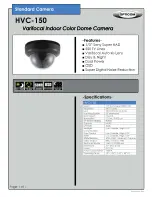
The JA-89P wireless outdoor PIR detector
The JA-89P wireless outdoor PIR detector
1 / 2
MKU51105
The JA-89P wireless outdoor intruder detector is designed to detect human
body movement in a protected area. It supplements a double-zone PIR
sensor produced by Optex with a Jablotron transmitter enabling the detector
to be used within the JA-8x OASiS 100 system. The optical part of the detector
has 2 PIR sensors and a high immunity to false alarms and the detection of
small animals. The detector includes an anti-masking function – protection
against covering the view and it also has two tampers (front and back) built in.
They immediately report opening the detector or attempting tampering. The
detector does a self-test periodically and sends its status to the control panel.
The detector should be installed by a trained technician with a valid certificate
issued by an authorised distributor.
Installation
Choose a proper place for detector installation according to the following:
1. The detector has to be installed onto a vertical wall (in a position where
its bottom surface is parallel to the watched zone).
2. The detector should be installed 0.8 – 1.2 m above the ground.
3. The best movement detection is provided when the detection beams
intersect.
4. No other moving objects (bushes, trees, high grass, air-conditioners, etc.)
should be situated in the field of view of the detector. Avoid direct action by
strong sources of light (sun reflections, etc.).
Note
: If multiple JA-89P detectors are used, they mustn´t be installed face
to face with each other and it’s recommended to install them with a
minimum 1 m distance.
Procedure:
1. Unscrew the locking screw placed on bottom of the upper cover of the
detector (1) and remove the detection part cover (1).
2. Unscrew the 2 screws which hold the detector´s main board (2) and
pull it out by tilting as you pull it out.
3. Remove the battery holder.
4. Remove the rear box cap (5).
5. Unscrew the 2 screws which link the rear cover (3) to the mounting
plate (4).
6. The detector can be mounted onto a level mounting place by the 2
screws through the mounting plate (4). Or it can be mounted on a pole
by ties.
7. Put the detector’s parts back together in the opposite order when it´s
finally fixed to the mounting place (4).
Warning
: Do not touch the detector sensing face during handling
.
1
2
3
4
5
Fig. 1.: 1 – front cover, 2 – detector main board, 3 – rear cover,
4 – mounting plate, 5 – rear cover cap
Fig. 2.: Detector installation. Standard wall installation and fixing by ties.
Enrolling the detector to the system
The signal transmitter for wireless communication is located under the
main board part of the detector. Read the manual of the receiving unit (control
panel) before you insert a battery into the transmitter. The batteries are inserted
into the battery holder of the OPTEX motion detector.
Always use a AA 3.6 V
lithium battery.
The correct position of the battery is indicated on the battery
holder.
Enrollment procedure to the system:
a. Read the installation manual of the receiving unit before you insert the
batteries into the detector. There must be a radio module installed in the
control panel.
b. Open the enrollment mode on the receiving unit.
c. Insert the batteries (mind the correct polarity). When the battery has
been inserted into the battery holder an enrollment signal is transmitted
to the control panel and the detector is enrolled to the selected position.
d. By DIP switch no.2 set the reaction to detected movement (ON =
Instant, 2 = delay). Leave DIP switch no.1 in position 1 (pulse mode).
e. Assemble the detector.
Rear tamper
connection
Switch No. 1
INSTANT
DELAYED
Switch No. 2
PULSE*
STATE
Vcc
TMP
INP
GND
detector
connection
LED
Set to
pulse mode
*
L
IT
H
IU
M
3
.6
V
A
A
Fig. 3 – The JA-89P detector transmitter
Setting up the optical part of the detector
The optical part of the detector includes 2 PIR sensors with AND logic.
They detect movement in two planes. The detecting angle of the lower PIR
sensor can be adjusted. The alarm signal is triggered if only both detecting
planes are triggered at the same time. By shifting the lens set up the tilt of
the lower detecting plane according to the following picture and table.
Fig. 4.
The following table represents the values included in the figure:
Position
Maximum range of the lower detecting
part
Average value
see following limits:
1
12 m
10 to 17 m
2
8.5 m
7 to 12 m
3
6 m
5 to 8.5 m
4
3.5 m
3 to 6 m
5
2.5 m
2 to 3.5 m
Table
1.
Warning:
The maximum detection length of the lower
detection plane may vary as above due to
environmental thermal conditions. This must be taken
into consideration during detection range adjustment.




















